Without advancements in steel, for example, skyscrapers would never have reached such heights, and façades would never have slimmed down without thin-shell concrete.
Construction has always included maintaining a set of balances: a balance between form and function, between design objectives and budgetary restraints, and between creative expression (as expressed in architects' works) and the practical concerns of the construction sector. In 2021, we must also factor in the challenges put on the building sector by climate change, the need to fulfil net-zero architecture, and overall sustainability.
What's next for architecture, given the fast development in material quality? New materials, which are occasionally created for unrelated industries, have the potential to affect the construction industry. These novel materials have the potential to alter how we interact with our buildings, as well as their longevity and look.
Carbon-fiber reinforced concrete
Researchers at the Technical University of Dresden have collaborated with Henn, a German architecture firm, to design the world's first concrete structure reinforced using carbon fibers rather than steel.
Researchers say that this newly created form of concrete has the same strength properties as concrete steel - reinforced rebar while using significantly less concrete. The concrete is reinforced with a carbon fiber strand, which is generated by pyrolysis, a thermal breakdown process that binds together numerous carbon fibers — ultra-thin threads of practically pure carbon crystals.

Credit: Dezeen
Self-Healing Concrete
The most serious flaw in concrete, the world's most frequently used construction material, is the unavoidable cracking induced by water and chemicals. However, new research out of the Netherlands has found a way to extend the life of this popular material by injecting it with bacterial spores that fill in fractures when water seeps through. This incredible new material technology is already being employed in real-world applications, such as a series of self-healing water tanks in the Netherlands.
Bacillus bacteria are mixed into self-healing concrete, and when they come into touch with calcium lactate contained in the mix when a rupture occurs, they produce limestone, which fills the fissures. Bacteria can remain latent in the mixture for up to 200 years, making it a long-term solution. Self-healing metal, on the other hand, doesn't cure big structural defects; instead, it fixes microscopic fissures that might endanger the structure's integrity in the future. Self-healing facades infused with nanomaterials can also save money on maintenance promoting sustainable architecture.

Credit: arches-global.com
Self-Cleaning Finishes
Self-cleaning claddings and finishes, which guard against filth and pollution, are becoming increasingly widespread as high-rise structures grow more common. Cleaning glassed facades may become obsolete with the use of such materials. Self-cleaning technology is beneficial not only for huge structures, but also for modest buildings and private houses. The design wins sustainable architecture points for water conservation and the absence of cleaning chemicals that can harm the environment by removing the need for cleaning. Self-cleaning coatings are available for several cladding materials, including aluminum, glass, and paint.
Nanomaterials enable this technique; the claddings are covered in a combination of nanoparticles that allow the material to reject water, oil, dust, and other liquids.
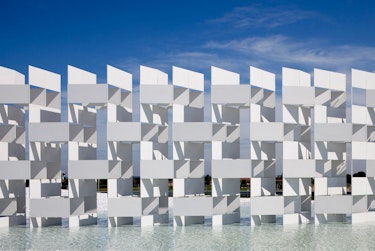
Credit: BigSEE
Spider Silk
Like our infatuation with diamonds as the "hardest substance on Earth," our fascination with silk, a naturally occurring material, never seems to fade. The super-fine substance is stronger than steel weight for weight, yet it is also extremely flexible. Scientists have long attempted to synthetically build the substance (in order to give the humble silkworm a rest), but have made little headway. However, a team from the MIT Media Lab has discovered a technique to manage silkworms to do their bidding in order to make a silk pavilion — essentially, printing with worms.
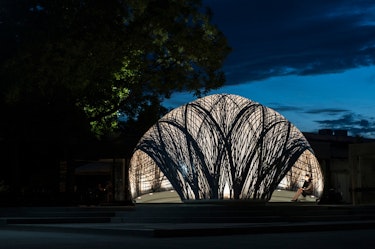
Credit: WIRED
Nanomaterials
Nanotechnology is propelling materials science to previously unthinkable heights. When coupled with ultra-high-strength concrete, nanomaterials such as Carbon Nanotubes (CNTs) produce a material that is so strong in both tension and compression that steel rebar is no longer required in emerging architecture, therefore speeding up the construction process. The options are endless. Other breakthroughs include ultralightweight (super-strong) materials and another type of self-healing concrete.
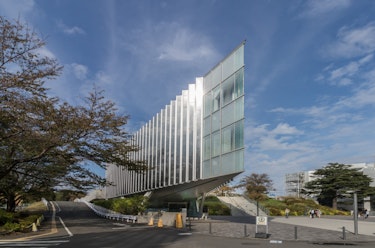
Credit: PV Magazine
Homeostatic Facades
In what is known as "biomimicry," this facade system responds to outdoor circumstances such as light and heat to assist the structure in maintaining desirable internal conditions. This system is made up of a dielectric ribbon (a polymer that reacts to electric impulses) wrapped in a double glass façade. Both sides of the material are covered with silver, which reflects light and distributes electricity across the surface, allowing it to morph to meet the needs of the structure.

Credit: ResearchGate
Bioplastic
Plastic is one of the most polluting substances on the planet, owing to its delayed biodegradability. Bioplastics, also known as biopolymers, are composed of algae, marine chitins, cellulose, and a wide range of renewable biomass resources. Because of its organic character, it degrades more easily after being discarded, offering it a green alternative to plastic created using fossil fuels. Cladding, structural components in sustainable architecture, and other architectural assisting structures might all benefit from the usage of bioplastic.
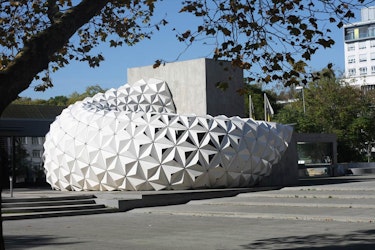
Credit: urbanNext
Aerogel Insulation
Whether it's due to climate change or just rising energy costs, practically everyone wants more efficient, greener new buildings. Insulation is thus a popular issue, particularly when it comes to aerogel, which is not only one of the lightest materials available, but also one of the most effective insulators (it also held 13 other Guinness World Records in 2011.) Originally created by NASA, a commercial spin-off, Thermablok, has evolved, particularly suited for household and commercial usage.
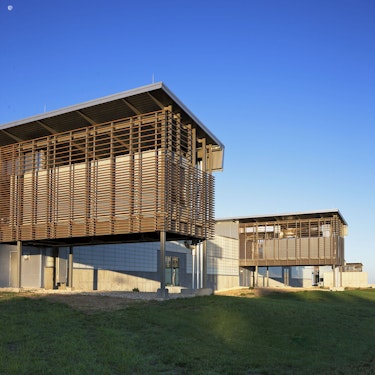
Credit: Kalwall
Pollution absorbing bricks
Breathe Brick is intended to be used in conjunction with a building's regular ventilation system, and features a double-layer brick façade with specialty bricks on the exterior, complimented by an interior layer that offers standard insulation. Breathe Brick is based on Cyclone Filtration, an idea borrowed from current vacuum cleaners that removes heavy polluting particles from the air and deposits them in a detachable hopper at the base of the wall.
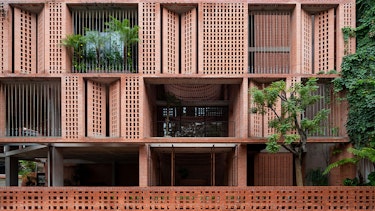
Credit: India Art N Design
Cigarette butts used to make more effective bricks
One person's garbage is another person's construction material. Researchers at the Royal Melbourne Institute of Technology (RMIT University) have found a method for producing bricks out of one of the world's most persistent sources of pollution: discarded cigarette butts. The team, led by Dr. Abbas Mohajerani, demonstrated that generating fired-clay bricks with as little as 1% cigarette butt content may totally balance yearly global cigarette production while also producing a lighter, more efficient brick. Before fire, mix the collected cigarette butts into the clay of the bricks. Aside from the environmental benefits, Mohajerani's team discovered that adding butts reduced the energy consumed in the burning process by up to 58 percent. The final bricks retained comparable structural qualities to standard bricks, but were lighter and more insulative. The fire process also captures toxic contaminants from cigarettes inside the bricks, preventing them from leaching into the environment.

Credit: Australian Design Review
The dawn of civilizations as we know it began with a succession of material advancements; after all, the Bronze and Iron Ages placed us on the route to where we are now. As a result, it's not surprising that history is intertwined with innovation in architecture.
